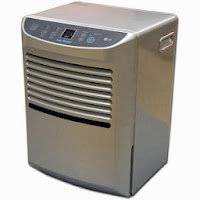While an air conditioner does dehumidify a room while it is running, it is only concerned with temperature, not moisture. Once the thermostat reaches the temperature you set it at, it shuts off, regardless of the humidity level in the room. Temperature and humidity have nothing to do with one another.
Using A Dehumidistat to Prevent Mold and Humidity
To prevent moisture and humidity in your home you can purchase a dehumidistat or a thermostat with a built-in dehumidistat that controls humidity. With a dehumidistat you select your desired humidity level. The air conditioner will kick on whenever humidity levels exceed your preset humidity setting. However, this may result in a more expensive energy bill every month. A dehumidistat will cause your AC to run often if you live in a very humid state such as Florida.
Preventing Mold and Humidity with a Dehumidifier
The other option you have to bring humidity levels down would be to purchase a dehumidifier. These are great for those that are concerned with conserving energy. The dehumidifier does not add cool air to bring down the humidity like the AC does. A dehumidifier is more of a slow and steady approach to reducing humidity in your home unlike the AC unit which is either full on or full off. The result is a comfortable house year round that uses less power.
Be sure to monitor and dump the collection tray often. Once the tray becomes full the built-in float switch will shut the unit off. It will no longer work until emptied. The ideal set up would be to install a drain line off the dehumidifier directly into a sink, outdoor through a wall or hard piped into an existing drain. Then the unit could be left unattended and continue to work as it purges regularly.
Ways to Reduce Humidity
- Never leave windows open in high humid environments as this can promote mold growth.
- Maintain your HVAC system. Change air filters regularly and get professional service once a year to clean the coils.
- Use bathroom exhaust fans to remove excess humidity after showers.
- Route exhaust fans (dryer, bathroom ventilation, stove top exhaust, etc.) completely outside of the home, not into any part of the home.
- Minimize indoor house plants.
- Make sure your property is dried properly if you experience a leak or water damage.
- Seal windows properly to prevent condensation on the glass. Condensation becomes humidity as it evaporates.
How Can PRS Prevent Mold and Humidity?
If you experience water damage or a leak, time is of the essence. Professional Restoration Services, Inc. is available 24 hours a day 365 days a year to efficiently and properly restore your home to it's pre-loss condition. With five state licenses, we are the one call does it all company. We have the necessary equipment to ensure your home will be properly dried to prevent mold. In the event you already have mold we are certified to assess and remove the mold as well. We are a certified and reputable company that understands the importance of an immediate response to your loss.





No comments:
Post a Comment